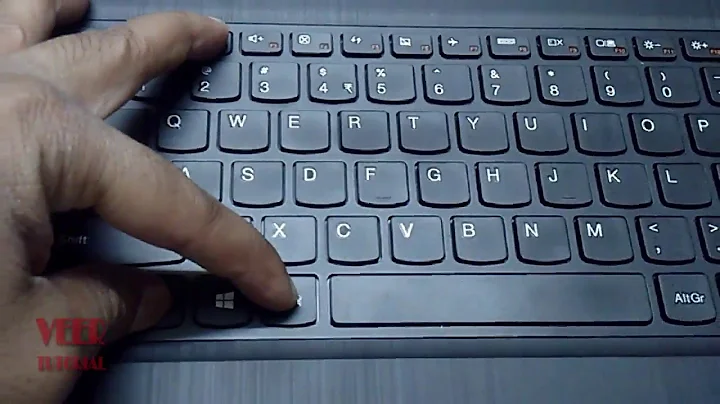Why can't we use/set function keys as password keys?
Solution 1
Passwords are nothing more but text; they contain characters, not keypresses. Computers aren't like mechanical typewriters, and there is a distinction between these two.
Using recorded keypresses for passwords would give nothing but disadvantages:
-
Security: Making the password longer can be more efficient security-wise than increasing the alphabet. (If you start with basic 26 letters, a 8-letter password has 268 = 208827064576 combinations. Expanding it to letters and numbers would give 368 combinations, 13.5x more. But if you instead just made it one letter longer, you'd get 269 possible passwords, exactly 26x more. Two letters longer? 2610 possibilities, 676 times as many. I'm on a horse.)
(Although on the other hand, simple calculations like that don't account for dictionary attacks, but I don't think the same people who use their name as a password would voluntarily do a function-key dance if it were possible.)
User expectations: Almost everyone thinks of a password as something containing words and letters (just kept secret). So if a key like F7 or Fn doesn't type a character normally, then it shouldn't type anything in password fields either. If it does something like resize the window or pop up Google, it should do exactly the same in password fields as well.
-
Primary purpose of the function keys: Some keys are used by the program itself, or by the operating system. Which keys are used varies between systems. Sometimes new keyboard shortcuts are added.
Let's say you used WinI in your password, then upgraded from Windows 98 to Windows 10; now you can't type your password anymore because WinI is used by the OS itself.
Or maybe you used FnRight with your old laptop, but it means "skip to next song" on your new one. Suddenly you can't log in to Gmail unless you close the music player first.
-
Variation between devices: Some keys don't exist in all keyboards. When was the last time you saw a PC desktop keyboard with a Fn key? Or a Mac keyboard with the Win key? Even the same PCs don't always have Pause or SysRq anymore.
How would you enter these keypresses on a mobile device? Let's say on a feature phone with 12 buttons? Or an iPhone, before they started allowing third-party keyboards...
People already have such problems. Often, they cannot even type their own script/language (even basic Latin-with-accents like
áorū) and are forced to stick to what the US QWERTY keyboard layout offers – that's the only thing that consistently works in public libraries and generally everywhere. -
Finally, the passwords remain text (and many OS components expect them to be text), so the OS would need to decide how to translate each keypress to something that can be stored as text.
xterm-like terminal apps already do this (as did actual physical terminals) – and yet, after three decades, they still haven't agreed on one way to do it. There are at least two different translations for arrow keys, and at least four different ways to translate F1-F12.
So you can input F3 and terminal-based programs will see it as text – but you don't know whether it will be
ESC O RorESC [ 1 3 ~orESC [ [ CorESC [ O...
Solution 2
Linux will take pretty much any keypress (except modifier keys by themselves) as input for passwords. On my arch system, I can easily set F12-F10-F9 as my password. F11 is missing in that row, because my window manager swallows that key and interprets it as the "fullscreen" command.
That's the issue with most stuff you probably tried: the window manager (GUI) will swallow certain keys before passing your input on to the program you're trying to enter data in. If you are in a console without any GUI on top of it, you'll be able to use pretty much anything you can imagine as password input.
EDIT: also note that some keyboards have their fn-key inputs hard-wired to hardware changes. For example, on my Lenovo fn+space will toggle the keyboard backlight completely independent of the OS. The OS doesn't even receive the keypress in this case.
EDIT EDIT: grawity's answer (ad the comments on this answer) goes into detail about why you probably don't want to do this.
Solution 3
That's dependent on the terminal, not the operating system.
Some terminals can be configured to store arbitrary strings; I did this for wyse-50's a while back, using escape sequences to program them.
More recently, you can set the translations resource in xterm to send a string. There is no escape sequence for this (which you would find useful: DECUDK is the closest, and sends its result in hexadecimal).
Some terminals (such as Terminal.app) have a preferences dialog which lets you put arbitrary strings there. Again, no escape sequence, but definitely configurable.
Some (apparently gnome-terminal and konsole) let you do some limited configuration of the keyboard.
Ultimately the answer reduces down to finding
- if the terminal you are using supports that feature, and
- if so, how to use it effectively.
Further reading:
This answer deals with passwords in terminals, rather than GUI. In a GUI, the application may not even see a function-key as text. GUIs have different constraints, e.g., (per comment) on Windows, passwords may be prompted in the security desktop, so it wouldn't matter much how the keyboard is setup. In particular, since that runs separated from other processes, you could not use an add-on (such as autohotkey) to store/paste passwords. Other GUIs have their own rules (see XSendEvent for instance), which are not necessarily determined by the operating system, but the runtime libraries.
Further reading:
Solution 4
Simply put, you can't use Fn key combinations in your password because there are no corresponding characters defined for these combinations. The point I want to make it that you shouldn't use non-standard keys when typing your password even if you could. If something goes wrong, you will be in trouble. You will know your password, but will be unable to type it:
- Your computer dies and you plug your HDD into a different one. You can't boot without HDD password, which you cannot type.
- You have no access to your computer (e.g. on a trip) and have to check an important e-mail. Good luck locating Fn or F1 on your phone.
etc.
Related videos on Youtube
BlueBerry - Vignesh4303
I love to wear redhat,bite some apples and throw it away through windows :)
Updated on September 18, 2022Comments
-
 BlueBerry - Vignesh4303 over 1 year
BlueBerry - Vignesh4303 over 1 yearIn any operating system the passwords with Fn were not allowed. For instance, I can't keep Fn + some character as password.
What's the reason behind it? Any technical aspect which prevents the operating system designers from allowing Fn keys as passwords?
A reason I can think of is that in some laptops the Fn keys will enable or disable the number keypad. But what about desktops? As desktop keyboards have separate Fn, why can't we use it in passwords?
-
 LPChip over 8 yearsWhat OS are you talking about? Windows, linux, mac?
LPChip over 8 yearsWhat OS are you talking about? Windows, linux, mac? -
 BlueBerry - Vignesh4303 over 8 yearsanything friend,by default all current operating systems till date doesnt allow function keys @LPChip
BlueBerry - Vignesh4303 over 8 yearsanything friend,by default all current operating systems till date doesnt allow function keys @LPChip -
Vality over 8 yearsI am not sure I have ever seen a keyboard with an fn key. Surely this itself is a motivator if it means many keyboards cannot type this password at all.
-
Chris H over 8 years@Vality: laptop keyboards use them (e.g. my netbook is too small for a number pad, by pressing [Fn] I can use a block of letter keys (and 7,8,9 from the number row). [Home] and [End] are only accessed using [Fn] but they couldn't be characters in passwords.
-
Chris H over 8 yearsThe behaviour on Ubuntu (14.04)'s login screen is interesting, and may give a clue as to some underlying reasons: I can enable the numpad using Fn+Numlock (normal for this keyboard) and then use the number keys successfully (it's not giving much away to admit that my password has digits in). With [Fn] + the same keys (recognised as numbers on win7) the keys act as arrow keys (plus Home, End...). This isn't expected behaviour. Maybe a combination of not loading the user's keyboard settings when they're not logged in, and a high potential for confusion makes it not worth implementing.
-
Mark Ch over 8 yearslol. fn keys are hardware specific. they're not even os specific. next you'll want to use the power, reset and brightness keys in your password
-
 Mark over 8 yearsThis is not true in the general case. Back in the System 7.5 days, I set a screen-unlock password that included the "F4" key. Drove my brother nuts trying to figure out why the password of "BOOKSHELF4" written on the sticky note wasn't working.
Mark over 8 yearsThis is not true in the general case. Back in the System 7.5 days, I set a screen-unlock password that included the "F4" key. Drove my brother nuts trying to figure out why the password of "BOOKSHELF4" written on the sticky note wasn't working. -
 oldmud0 over 8 yearsWell, you can use Ctrl+Backspace for your password on Windows ;)
oldmud0 over 8 yearsWell, you can use Ctrl+Backspace for your password on Windows ;) -
Pavel over 8 years@MarkCh I would find it quite hilarious with the ubiquitous Autobrightness in all today's handheld computers. Users running to find shadow for their Facebook log-in...
-
-
 LPChip over 8 yearsIn windows, fn+key is handled the same as media keys. It requires a special way of capturing the key which is something that is not supported on Windows, so the OS really does matter.
LPChip over 8 yearsIn windows, fn+key is handled the same as media keys. It requires a special way of capturing the key which is something that is not supported on Windows, so the OS really does matter. -
 Thomas Dickey over 8 yearsOn Windows, passwords may be prompted in the security subsystem, so it wouldn't matter much how the keyboard is setup (agreed).
Thomas Dickey over 8 yearsOn Windows, passwords may be prompted in the security subsystem, so it wouldn't matter much how the keyboard is setup (agreed). -
user1686 over 8 yearsThe Windows "security subsystem" isn't magic. It doesn't hook into the keyboard drivers or anything. If it ever shows a password prompt, that's a regular password prompt.
-
 Thomas Dickey over 8 yearsI didn't say it was. Along those lines, much of your answer I find not useful.
Thomas Dickey over 8 yearsI didn't say it was. Along those lines, much of your answer I find not useful. -
 IMSoP over 8 yearsNote that your password doesn't actually consist of F12-F10-F9; if you know what ASCII sequence it has been encoded as, you could type (or paste) that instead. The one control code (i.e. non-printable character) you are actually saving to the password is likely to be ESC (ASCII 27), indicating the start of an escape sequence.
IMSoP over 8 yearsNote that your password doesn't actually consist of F12-F10-F9; if you know what ASCII sequence it has been encoded as, you could type (or paste) that instead. The one control code (i.e. non-printable character) you are actually saving to the password is likely to be ESC (ASCII 27), indicating the start of an escape sequence. -
 IMSoP over 8 yearsI just tested, and F3 translates as
IMSoP over 8 yearsI just tested, and F3 translates asESC O Rfor me, notESC O Q; I think you might have an off-by-one error ;) -
 Simon over 8 years@IMSoP Yup, this is covered very well Grawity's answer.
Simon over 8 years@IMSoP Yup, this is covered very well Grawity's answer. -
Kilian Foth over 8 yearsDoing this will bite you whenever there is a change in your environment that causes different text to be generated by the same function key. It could be as minor as a locale change, a remote X session, or a desktop environment upgrade, and you'll be unable to log on.
-
 Engineer Toast over 8 yearsI'm most interested in the example where someone upgrades from Win98 to Win10.
Engineer Toast over 8 yearsI'm most interested in the example where someone upgrades from Win98 to Win10. -
user1686 over 8 years@EngineerToast: Chain of fools? You just have to temporarily downgrade to ME, then upgrade to 2000 and XP, then downgrade to Vista, upgrade to Win7, downgrade to 8, upgrade to 8.1, etc.
-
 Nzall over 8 yearsEspecially the "variation between devices" part is why, even with a password manager, I limit my passwords to purely alphanumeric and compensate with length where possible. If I ever need to enter a password manually (as I had to do today), I won't struggle excessively, especially on a mobile device.
Nzall over 8 yearsEspecially the "variation between devices" part is why, even with a password manager, I limit my passwords to purely alphanumeric and compensate with length where possible. If I ever need to enter a password manually (as I had to do today), I won't struggle excessively, especially on a mobile device. -
 Joshua over 8 yearsIncidentally I got a backspace in my password. That was a pain.
Joshua over 8 yearsIncidentally I got a backspace in my password. That was a pain. -
 jpmc26 over 8 years@grawity Pretty sure an upper end Win 98 machine couldn't support Win 10. The only really viable way I can think of is, "use Win 98 from 99 to 2015, buy new computer in 2015."
jpmc26 over 8 years@grawity Pretty sure an upper end Win 98 machine couldn't support Win 10. The only really viable way I can think of is, "use Win 98 from 99 to 2015, buy new computer in 2015." -
Matthew Najmon over 8 yearsFn keys are not "100% operating system specific". They're roughly 95% hardware specific, and maybe 5% OS specific. Either way, though, ASCII standards do exclude them.
-
 Scott - Слава Україні over 8 years@jpmc26: I'm running Windows 7 Professional on a laptop that's less than two years old; it's nice (64-bit, 8 GB, etc ...) but not "upper end". And yet, Microsoft has been bombarding me with enticements to upgrade to Windows 7, and I've heard reports that they do that only after they've ascertained that your system meets the qualifications for the upgrade.
Scott - Слава Україні over 8 years@jpmc26: I'm running Windows 7 Professional on a laptop that's less than two years old; it's nice (64-bit, 8 GB, etc ...) but not "upper end". And yet, Microsoft has been bombarding me with enticements to upgrade to Windows 7, and I've heard reports that they do that only after they've ascertained that your system meets the qualifications for the upgrade. -
 phuclv about 7 years@grawity that man has included windows 10 in his latest version youtu.be/PH1BKPSGcxQ
phuclv about 7 years@grawity that man has included windows 10 in his latest version youtu.be/PH1BKPSGcxQ





